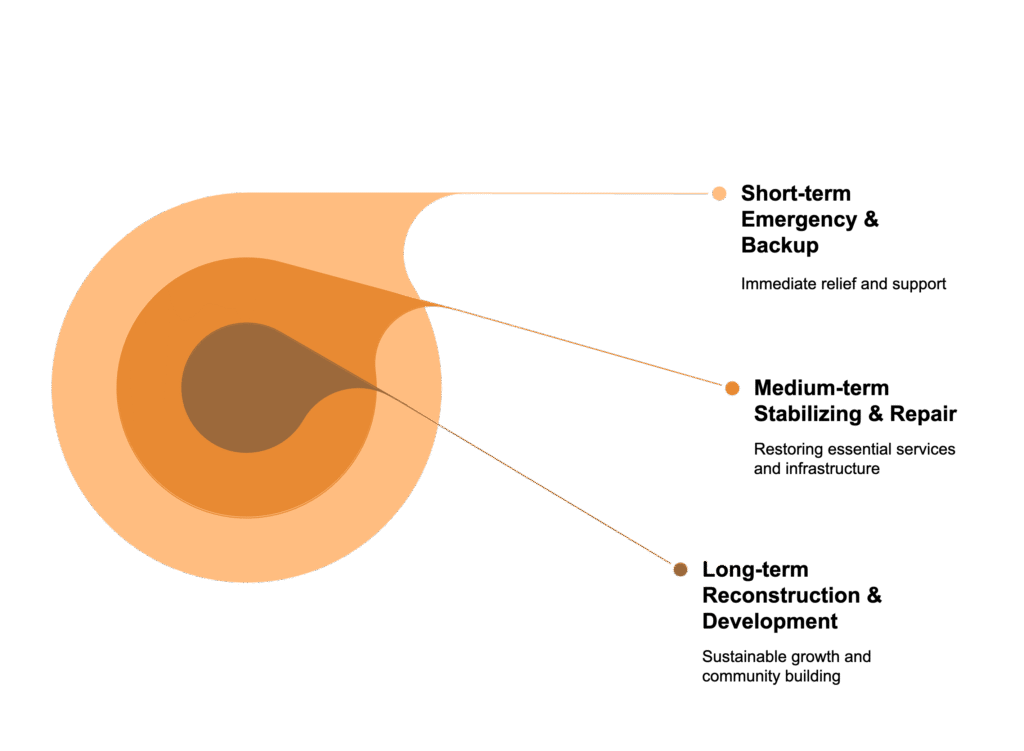The Phoenix Gaza Framework is built on a collaborative, interdisciplinary process that integrates local knowledge, academic research, and spatial planning expertise. Shaped through internal deliberations, field data, and input from municipal actors, the methodology unfolds in three main phases—emergency, stabilization, and long-term reconstruction—each aligned with specific criteria, spatial components, sectoral actions, and community-defined priorities. This flexible, non-linear approach ensures that Gaza’s rebuilding is grounded in its diverse realities and led by its people.

The Phoenix Gaza Framework is grounded in the belief that reconstruction is not simply technical recovery—it is political, cultural, and existential. Its methodology rejects imposed master plans or extractive consultancy approaches. Instead, it embraces local authorship, voluntary collaboration, and collective visioning, drawing on the lived experience, memory, and expertise of Palestinians across geographies.
It enshrines dignity, participation, justice, and rootedness as foundational planning principles.
The methodology is the outcome of a collaborative process between Palestinian professionals and scholars from Gaza, the West Bank, and the diaspora. It involved:
Interdisciplinary dialogue across planning, heritage, environment, public health, law, and urban design.
Workshops and internal review sessions engaging municipal actors, local experts, and academics.
Presentations in international forums to gather wider insights.
Hundreds of hours of volunteer work by students and researchers, notably from Birzeit University.
The Phoenix Gaza methodology unfolds in three interlinked components:
Introductory Package: Defines the team, methodology, values, and structure.
Roadmap to Rebuilding Gaza: Operationalizes the reconstruction across timeframes and scales.
Annexes: Provides detailed tools, mapping, and data that support implementation.
The framework is organized into three time-based phases, each designed to be adaptive to shifting realities:
Emergency Phase (E): Focuses on urgent needs—shelter, mobility, water, energy, and resilience.
Stabilization Phase (S): Repairs and consolidates urban and community systems.
Reconstruction Phase (R): Envisions a just, future-oriented Gaza that integrates heritage, equity, and sustainability.
Interventions are coordinated across four spatial scales, ensuring that micro-level design reflects macro-level policy:
The team conducted GIS-based analysis and remote mapping to anchor every proposal in on-the-ground realities.
10 key indicators guide every spatial and policy decision.
Planning decisions are based on GIS mapping, damage analysis, and socio-spatial indicators.
The document is designed for both holistic and targeted use:
Comprehensive reading offers a full picture of the reconstruction strategy.
Sector-based reading enables experts (e.g., in water, housing, or heritage) to go straight to the relevant actions in each phase.
A navigation matrix maps intersections between phases and sectors, helping planners find what they need efficiently.
Designed for flexible use—read by phase, sector, or strategy.
The document includes a navigation matrix allowing targeted or comprehensive reading
Unlike static masterplans, the Phoenix Gaza Framework is a living methodology. It is intended to:
Evolve through consultation and implementation feedback.
Serve as a platform for negotiation between actors (state, municipal, community).
Align short-term relief with long-term, emancipatory urbanism.
A living framework to guide action, negotiation, and adaptation.”
This is not a static plan but a platform for local ownership, feedback, and continuous evolution.